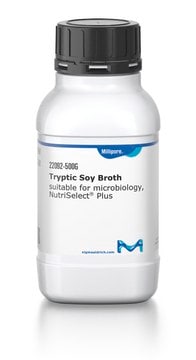70138
Brain Heart Infusion Agar
suitable for microbiology, NutriSelect® Plus, For the cultivation of fastidious, pathogenic bacteria, yeasts, and molds
Synonym(s):
BHI Agar
About This Item
Recommended Products
Quality Level
sterility
non-sterile
product line
BioChemika
form
powder
shelf life
limited shelf life, expiry date on the label
composition
agar, 15 g/L
brain extract, 7.8 g/L
dextrose, 2.0 g/L
disodium phosphate, 2.5 g/L
heart extract, 9.7 g/L
proteose peptone, 10.0 g/L
sodium chloride, 5.0 g/L
manufacturer/tradename
NutriSelect® Plus
technique(s)
microbe id | specific enzyme detection: suitable
microbiological culture: suitable
final pH
7.4±0.2 (25 °C)
pH
7.2-7.6 (25 °C)
application(s)
clinical testing
environmental
food and beverages
life science and biopharma
water monitoring
microbiology
storage temp.
10-30°C
suitability
Ajellomyces spp.
Blastomyces spp.
Enterococcus spp.
Erysipelothrix spp.
Haemophilus spp.
Pneumococcus spp.
nonselective for Candida spp.
nonselective for Clostridium spp.
nonselective for Escherichia coli
nonselective for Lactobacillus spp.
nonselective for Neisseria spp.
nonselective for Shigella spp.
nonselective for Staphylococcus spp.
nonselective for Streptococcus spp.
nonselective for bacteria (General Media)
nonselective for coliforms
General description
This medium is less suited for identifying haemolytic forms when blood is added due to its glucose content. While handling Histoplasma capsulatum extreme care should be taken to avoid dissemination of its infective spores. The culture should be examined in a closed filtered air cabinet.
Application
Defibrinated sheep blood added to the basal medium provides essential growth factors for the more fastidious fungal organisms.
Preparation Note
Other Notes
Footnote
The designations basic, plus, or prime are added to indicate the quality control level, from basic quality control to standard QC plus to prime for full regulatory compliance.
Legal Information
Storage Class Code
11 - Combustible Solids
WGK
WGK 3
Flash Point(F)
Not applicable
Flash Point(C)
Not applicable
Personal Protective Equipment
Choose from one of the most recent versions:
Already Own This Product?
Find documentation for the products that you have recently purchased in the Document Library.
Customers Also Viewed
Articles
Clostridia are relatively large, gram-positive, rod-shaped bacteria that can undergo only anaerobic metabolism.
Clostridia are relatively large, gram-positive, rod-shaped bacteria that can undergo only anaerobic metabolism.
Clostridia are relatively large, gram-positive, rod-shaped bacteria that can undergo only anaerobic metabolism.
Clostridia are relatively large, gram-positive, rod-shaped bacteria that can undergo only anaerobic metabolism.
Our team of scientists has experience in all areas of research including Life Science, Material Science, Chemical Synthesis, Chromatography, Analytical and many others.
Contact Technical Service











